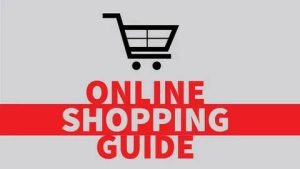Here’s a comprehensive online shopping guide to help you navigate the world of e-commerce and make informed purchasing decisions:
- Research and Compare: Start by researching the product you want to buy. Read reviews, compare prices, and gather information about different brands or models. This step ensures that you have a good understanding of the product and can make an informed decision.
- Choose a Reliable Online Retailer: Select a reputable online retailer to make your purchase. Look for well-established platforms with a track record of reliable service, secure payment options, and positive customer reviews. Popular online retailers include Amazon, eBay, Walmart, and Best Buy.
- Check Product Details: Carefully review the product details, including specifications, features, dimensions, and images. Ensure that the product meets your requirements and preferences. Pay attention to important information such as warranty, return policy, and shipping details.
- Compare Prices: Compare prices across different online retailers to find the best deal. Consider any additional costs such as shipping fees or taxes. Keep in mind that the lowest price may not always indicate the best value. Consider factors like reputation, customer service, and product quality when making a decision.
- Read Customer Reviews: Read customer reviews and ratings for the product you intend to buy. This provides insights into the experiences of other customers and helps you gauge the product’s quality, performance, and durability. Focus on recent and detailed reviews for a more accurate assessment.
Research and Compare
Researching and comparing products is an essential step in the online shopping process. It allows you to make informed decisions, find the best deals, and ensure that you purchase a product that meets your needs and preferences. Here’s a guide on how to research and compare products when shopping online:
- Define Your Needs: Start by identifying your specific needs and requirements for the product you want to buy. Consider factors such as the purpose, features, size, specifications, and any other important criteria that are relevant to your purchase decision.
- Search Online Retailers: Begin your research by exploring reputable online retailers that offer the product you’re looking for. Check well-known platforms like Amazon, eBay, Walmart, and specialized retailers that cater to specific product categories. Take note of the retailers that consistently receive positive reviews and have a wide selection of products.
- Read Product Descriptions: Click on the product listings to access detailed product descriptions. Pay close attention to the specifications, features, dimensions, materials, and any other relevant details provided by the retailer. This information helps you evaluate whether the product meets your requirements.
- Check Customer Reviews and Ratings: Read customer reviews and ratings for the products you’re considering. Customer reviews provide firsthand experiences and insights into the product’s quality, performance, durability, and any potential issues. Focus on reviews from verified purchasers and consider both positive and negative feedback.
- Consider Expert Reviews: Look for expert reviews from reputable sources such as professional product review websites, blogs, or magazines. Expert reviews often provide in-depth analysis, comparisons, and objective assessments of products based on their expertise and testing.
Choose a Reliable Online Retailer
Choosing a reliable online retailer is crucial to ensure a positive shopping experience and to protect your personal and financial information. Here’s a guide on how to select a reliable online retailer:
- Reputation and Trustworthiness: Look for well-established online retailers with a strong reputation and positive customer reviews. Research the retailer’s history, customer satisfaction ratings, and overall trustworthiness. Check for certifications or awards that demonstrate their commitment to customer service and security.
- Secure Website: Prioritize online retailers that have secure websites. Look for indicators such as a padlock icon in the browser’s address bar, “https” in the website URL (instead of “http”), or other security seals or badges that indicate the site’s commitment to protecting customer information.
- Customer Reviews and Ratings: Read customer reviews and ratings for the online retailer. Look for reviews that highlight the overall shopping experience, customer service, shipping, and product quality. Consider both recent and overall ratings to get a comprehensive understanding of the retailer’s performance.
- Variety and Selection: Consider the variety and selection of products offered by the retailer. A reliable online retailer should have a wide range of products from different categories, allowing you to find what you need in one place. This demonstrates their commitment to meeting customer demands.
- Clear Policies: Review the retailer’s policies, including shipping, returns, refunds, and privacy. Ensure that the policies are transparent, customer-friendly, and aligned with your expectations. Look for details on shipping fees, delivery times, return shipping options, and any restocking fees.
Remember, it’s important to exercise caution and use your best judgment when selecting an online retailer. Take the time to research and consider all the factors mentioned above to ensure a safe and satisfactory online shopping experience.
Check Product Details
Checking product details is essential when shopping online to ensure that you’re making an informed purchase. Here’s a guide on how to effectively check product details:
- Read the Product Description: Start by thoroughly reading the product description provided by the online retailer. It should contain detailed information about the product, including its specifications, features, dimensions, materials used, and any other relevant details. Pay attention to specific product variations or options, such as color, size, or model variations.
- Examine Product Images: Carefully examine the product images provided by the retailer. Look for multiple images that showcase different angles and close-ups of the product. Zoom in on the images if possible to get a better view of the product’s details, textures, and finishes.
- Check Product Specifications: Pay close attention to the product specifications mentioned in the description. This includes dimensions, weight, capacity, power requirements, and any other relevant technical details. Ensure that the product’s specifications align with your requirements and intended use.
- Assess Materials and Construction: Consider the materials used in the product’s construction. Check if the materials are of high quality, durable, and suitable for your needs. If the product has specific certifications or standards (e.g., eco-friendly materials, safety certifications), verify that these are mentioned in the description.
- Look for Additional Features: Determine if the product has any additional features or functionalities that make it unique or more desirable. Examples include adjustable settings, compatibility with other devices, special modes, or convenience features. Assess whether these additional features align with your preferences and requirements.
By following these steps and thoroughly checking product details, you can ensure that you have a clear understanding of the product’s specifications, features, materials, and other relevant information. This knowledge will help you make a confident purchase and avoid any surprises or disappointments when the product arrives.

Compare Prices
Comparing prices is an important step in online shopping to ensure that you’re getting the best deal and value for your money. Here’s a guide on how to effectively compare prices when shopping online:
- Start with a List: Create a list of the products you’re interested https://www.buydo.eu in purchasing. Include the specific variations or options you’re considering, such as color, size, or model. Having a clear list will help you stay organized and focused during the price comparison process.
- Use Comparison Shopping Websites: Utilize comparison shopping websites or price comparison tools to quickly compare prices across multiple online retailers. These platforms aggregate prices from various sellers, allowing you to see a side-by-side comparison of the same product from different sources. Popular comparison shopping websites include Google Shopping, PriceGrabber, and Shopzilla.
- Check Multiple Online Retailers: Visit the websites of different online retailers that sell the products you’re interested in. Look for well-known and reputable retailers that offer a wide range of products. Compare prices on these websites, keeping in mind any additional costs such as shipping fees or taxes.
- Consider Shipping and Additional Costs: Take into account any additional costs associated with the purchase. Some retailers may offer free shipping, while others may charge for shipping based on the product’s weight, location, or shipping method. Factor in these costs when comparing prices to get a more accurate picture of the total expense.
- Look for Discount Codes and Promotions: Check if there are any discount codes, coupons, or ongoing promotions available for the products you’re considering. Retailers often offer promotional codes or limited-time discounts that can significantly reduce the price. Look for these opportunities to further save on your purchase.
By following these steps and comparing prices from various sources, you can find the best deals and make an informed decision on your online purchases. Remember to consider other factors besides price, such as shipping costs, additional fees, reputation, and overall value, to ensure a satisfactory shopping experience
Read Customer Reviews
